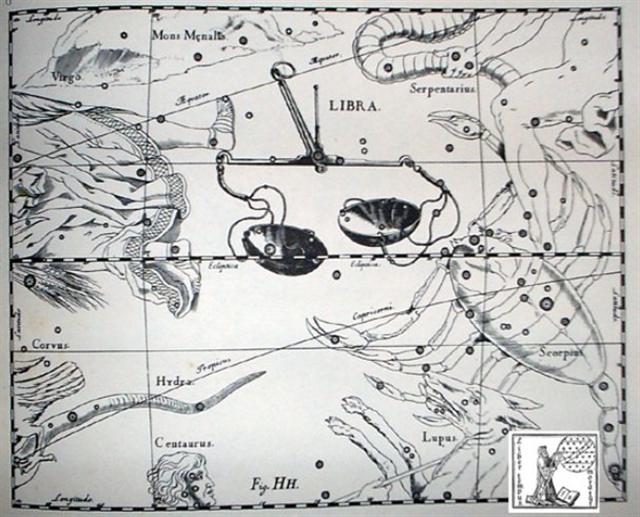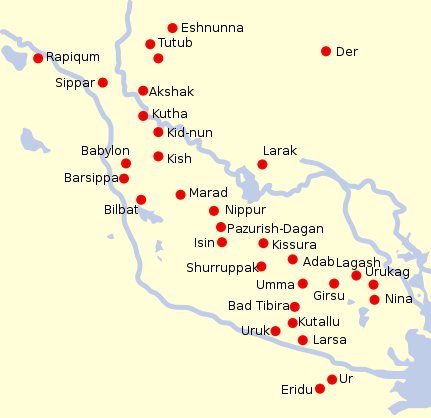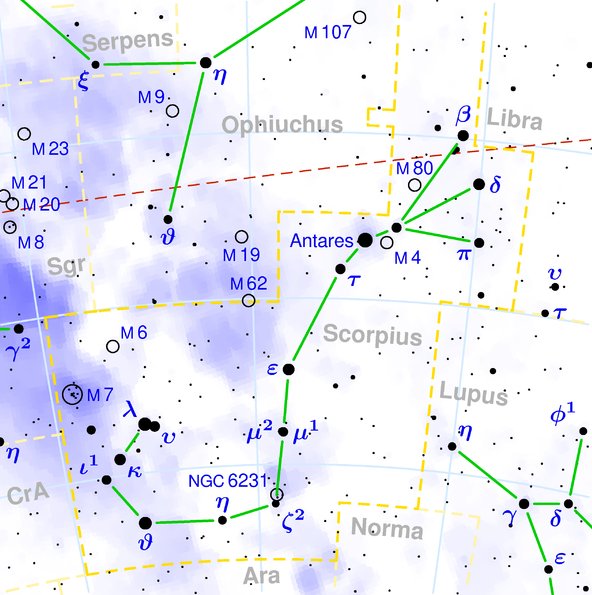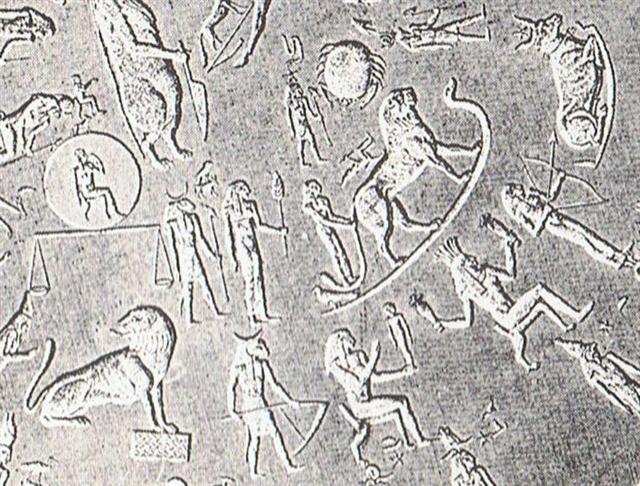272. Hevelius has another picture where it was not the toe of Virgo but the heel of her right foot which touched (and therefore defined the position of) the Libra beam:
At first, when I noticed this phenomenon - how he had used a pair of different perspectives - it puzzled me. But the explanation could be that the big toe at the front of the Virgo right foot signified the Sun (and his calendar), whereas the back side of her foot indicated nighttime (and the past). ... For the Maori the past is an important and pervasive dimension of the present and future. Often referred to as the 'ever-present now', Maori social reality is perceived as though looking back in time from the past to the present ... The rongorongo glyphs are flowing from left to right and into the past. But as time circulates the present will return beyond the past.
... Gilgamesh has no metaphysical temperament like the Lord Buddha. He sets out on his great voyage to find Utnapishtim the Distant, who dwells at 'the mouth of the rivers'
"Eridhu, or Eri-duga, the Holy City, Nunki, or Nunpe, one of the oldest city in the world, even in ancient Babylonia, was that kingdom's flourishing port on the Persian Gulf, but, by the encroachments of the delta, its site is now one hundred miles inland. In its vicinity the Babylonians located their sacred Tree of Life." (Allen) and who can possibly tell him how to attain immortality. He arrives at the pass of the mountain Mashu ('Twins'), 'whose peaks reach as high as the banks of heaven - whose breast reaches down to the underworld - the scorpion people keep watch at its gate - those whose radiance is terrifying and whose look is death - whose frightful splendor overwhelms mountains - who at the rising and setting of the sun keep watch over the sun'. The hero is seized 'with fear and dismay', but as he pleads with them, the scorpion-men recognize his partly divine nature. They warn him that he is going to travel through a darkness no one has traveled, but open the gate for him. 'Along the road of the sun (he went?) - dense is the dark(ness and there is no light)' (Tabl. 9, col. 4, 46). The successive stretches of 1, then 2, then 3, and so on to 12 double-hours he travels in darkness. At last it is light, and he finds himself in a garden of precious stones, carnelian and lapis lazuli, where he meets Siduri, the divine barmaid, 'who dwells by the edge of the sea'. Under the eyes of severe philologists, slaves to exact 'truth', one dare not make light of this supposedly 'geographical' item with its faint surrealistic tang. Here is a perfectly divine barmaid by the edge of the sea, called by many names in many languages. Her bar should be as long as the famed one in Shanghai, for she has along her shelves not only wine and beer, but more outlandish and antiquated drinks from many cultures, drinks such as a honeymead, soma, sura (a kind of brandy), kawa, pulque, peyote-cocktail, decoctions of ginseng. In short, from everywhere she has the ritual intoxicating beverages which comfort the dreary souls who are denied the drink of immortality. One might call these drinks Lethe, after all. Earnest translators have seriously concluded that the 'sea' at the edge of which the barmaid dwells must be the Mediterranean, but there have also been votes for the Armenian mountains. Yet the hero's itinerary suggests the celestial landscape instead, and the scorpion-men should be sought around Scorpius. The more so as lambda ypsilon Scorpii are counted among the Babylonian mashu-constellations, and these twins, lambda ypsilon, play an important role also in the so-called Babylonian Creation Epic, as weapons of Marduk ...
The constellations can be viewed (and drawn) as they would appear from an observer down on the earth (with right ascension time increasing towards the left) or they can be imagined from a point outside the celestial sphere (with time running from left to right). The latter was the normal method used by Hevelius. ... Two men came to a hole in the sky. One asked the other to lift him up. If only he would do so, then he in turn would lend him a hand. His comrade lifted him up, but hardly was he up when he shouted for joy, forgot his comrade and ran into heaven. The other could just manage to peep over the edge of the hole; it was full of feathers inside. But so beautiful was it in heaven that the man who looked over the edge forgot everything [→ Lethe], forgot his comrade whom he had promised to help up and simply ran off into all the splendour of heaven ...... Here is a perfectly divine barmaid by the edge of the sea, called by many names in many languages. Her bar should be as long as the famed one in Shanghai, for she has along her shelves not only wine and beer, but more outlandish and antiquated drinks from many cultures, drinks such as a honeymead, soma, sura (a kind of brandy), kawa, pulque, peyote-cocktail, decoctions of ginseng. In short, from everywhere she has the ritual intoxicating beverages which comfort the dreary souls who are denied the drink of immortality. One might call these drinks Lethe, after all ...
When the heel of Virgo touched the beam of Libra it did not disturb its direction - it remained horizontal. The precession of the Sun did not affect the order of the star figures as observed in the night, the stars remained fixed. I think Hevelius by this exception to his normal method of presenting the constellations wished to draw the viewers' attention to the fact that Libra had a special function in the past - it had been used to define the place of autumn equinox. Similarly the creator of the C text seems to have drawn attention to this place - 41 right ascension days back in time - by using a niu at Kochab in the day after Zuben Elgenubi.
The creator of the C text has, as if to indicate contrast, put the current star at the north pole, Polaris, at the end of side a (i.e. 16 right ascension days/glyphs earlier in the text than Kochab, β Ursae Minoris), in the day preceding Sheratan (= The First Point of Aries in Roman times). When the Sun (in principle) reached Kochab then Polaris would (in principle) return to visibility - 16 days being the minimum period before a star would return in the early morning sky after having been too close to the Sun for observation. ... The Arabs knew Polaris as Al Kiblah, 'because it is the star least distant from the pole', although then 5░ away, and helped them, in any strange location distant from an established point of worship, to know the points of the compass and thus the direction to Mecca and its Kabah╣, towards which every good Muslim must turn his head in prayer. ╣ This ancient Square House, probably an early Sabaean temple, was built, tradition says, first in heaven; then for Adam on earth as a tabernacle of radiant clouds let down by the angels directly under its celestial site. This, disappearing at his death, was replaced by one of stone and clay by the patriarch Seth, that in its turn was swept away by the Deluge. Lastly it was erected by Abraham and Ishmael to contain the Black Stone, Al Hajar al Aswad, a ruby, or jacinth, brought from heaven by Gabriel and now blackened by the pilgrims' tears, or because so often kissed by sinners; but it is generally regarded by unbelievers as a meteorite. The Century Cyclopedia, however, describes it as an irregular oval about seven inches in diameter, composed of about a dozen smaller stones of various shapes and sizes. The Stone is set into the northeast corner of the wall, at a convenient height for kissing. They also claled it Al Jadī, the Young He Goat, which subsequently degenerated to Juddah, as Niebuhr heard it a century ago, and known in Desert story as Giedi, the slayer of the dead man on the Bier of Ursa Major. Wetzstein says that in Damascus it is called Mismār, a Needle or Nail. As marking the north pole it bore the latter's title, Al Kutb al Shamāliyy, the Northern Axle, or Spindle, from Al Kutb, the Pin fixed in the under stone of a mill around which the upper stone turns; and this same thought later appeared in English poetry, as in Marlowe's History of Doctor Faustus, where he says of the stars that All jointly move upon one axletree // Whose terminine is term'd the world's wide pole. The Arabian astronomers knew it as Al Kaukab▓ al Shamāliyy, the Star of the North, ▓ Kaukab is the same as the Assyrian and Chaldean word Kakkab, the Hebrew Kōhābh; this last has also the fighting name of Bar Cochab, the Son of a Star, who was the leader of the second revolt of the Jews in 132-135, during the reign of Hadrian, his shekels bearing a star over a tetrastyle temple. The name was variosly written, but correctly as Bar Coziba, from his birthplace. an appellation perhaps given by their nomad ancestors to β [Kochab] as nearer the pole in their time ... The Young He Goat (Gredi), the slayer of the dead man imagined on the Bier - as defined by the 4 great star corners on the torso of Ursa Major (Itzam-Yeh) - could have been One-Ahaw:
... This pot depicts one of the Hero Twins (One-Ahaw in the Classic texts and One-Hunaphu in the K'iche' Popol Vuh) and a great bird who is trying to land in a huge ceiba tree heavy with fruit. This mythical bird is Itzam-Yeh, Classic prototype of Wuqub-Kaqix, 'Seven-Macaw', of Popol Vuh fame. In that story, in the time before the sky was lifted up to make room for the light, the vainglorious Seven-Macaw imagined himself to be the sun. Offended by his pride, the Hero Twins humbled him by breaking his beautiful shining tooth with a pellet from their blowgun. This pot shows One-Ahaw aiming at the bird as he swoops down to land in his tree. As Itzam-Yeh lands on his perch, the text tells us he is 'entering or becoming the sky'. This particular 'sky-entering' is not the one mentioned in the Palenque text. It is the final event that occurred in the previous creation before the universe was remade. Before the sky could be raised and the real sun revealed in all its splendor, the Hero Twins had to put the false sun, Itzam-Yeh, in his place. If the date on this pot corresponds to that pre-Columbian event, as we believe it does, then Itzam-Yeh was defeated on 12.18.4.5.0.1 Ahaw 3 K'ank'in (May 28, 3149 B.C.). After the new universe was finally brought into existence, First Father also entered the sky by landing in the tree, just as Itzam-Yeh did ...
|










